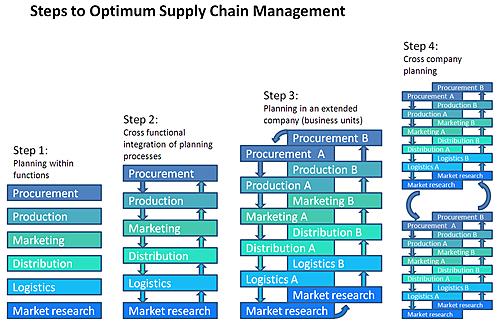Supply Chain Management ImplementationCross-group implementationThe objective of a cross-group implementation is to plan, control and record business processes, starting with the staff in the individual divisions, it continues with the divisions and business units and finally across the group. The step-like structure of a cross-group implementation is illustrated and described in the graphic below.

| 
please click to enlarge
|
Steps involved in a cross-group implementationIn the first step, only the functional or divisional planning is defined. The individual divisions analyse and plan their processes independently from each other.
Step two extends the planning to cross-divisional/functional processes by connecting sales, production and distribution in a cross-divisional process (e.g. product release).
In the third step, planning across all business units or with customers and suppliers derived from step-one can be conducted. Links between Shared processes from different business units are created at this stage. We are referring to scenario such as, for example, a semi-finished product that may be used for the procurement of two different final products, or two different distribution channels that may offer the same product to different customer segments.
Cross-group planning as shown in step four is the final objective in the achievement of an ideal supply chain. However, this remains an objective, as we are not aware of any Company having achieved it as yet. The global supply chain network can be seen as a virtual marketplace where competing suppliers offer their materials and the buyer is able to choose between different procurement alternatives. This leads to cross-group planning, global cooperation and optimization of business partnerships.
|  Competencies
Competencies  Industries
Industries  Publications
Publications  Career
Career 